My first award in sports
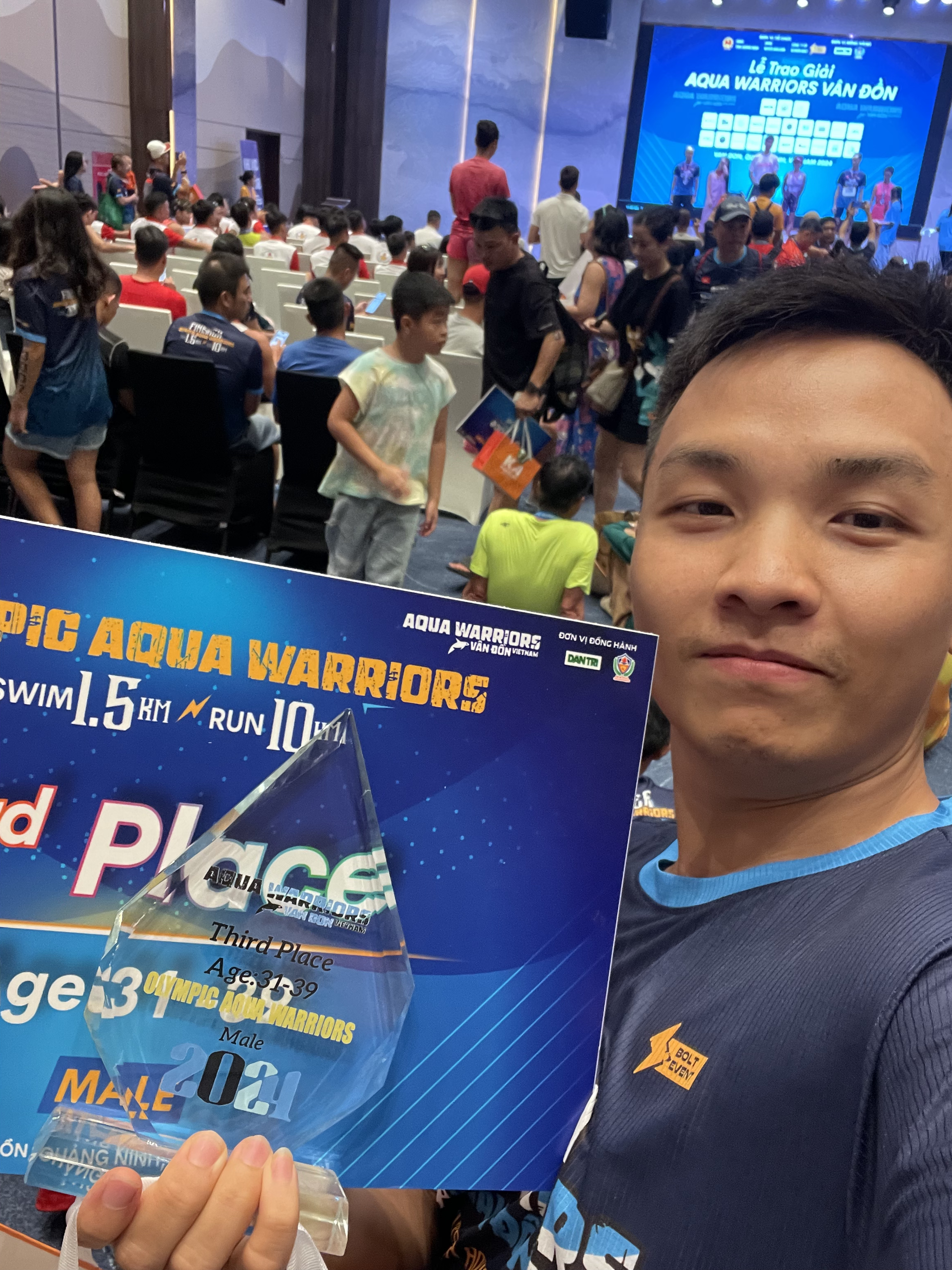
One year ago, I couldn’t even imagine participating in open water swimming. Fast forward to this year, I’ve “overcome countless obstacles” to achieve my first sports title. I secured a top 3 position in my age group for the Olympic distance (1.5km ![]() , 10km
, 10km ![]() ) at the Aqua Warriors Series, held in late September 2024 in Van Don, Quang Ninh. This event has significantly boosted my spirit and changed my mindset about physical training.
) at the Aqua Warriors Series, held in late September 2024 in Van Don, Quang Ninh. This event has significantly boosted my spirit and changed my mindset about physical training.
1. Why Open Water?
Open water swimming presents a different set of challenges compared to the endurance difficulties I faced while conquering various running distances. It involves a significant psychological aspect when swimming in open water, combined with the technical demands of swimming. Through this journey, I discovered my next favorite sport (after running) and have plans to excel in it.
Before deciding to swim in open water, around late 2023, I taught myself to swim by watching YouTube videos, especially channels like Thay Chien Day Boi and Yeu Boi Loi. I managed to swim both breaststroke and freestyle for a few hundred meters. My best performance was ![]() 1km freestyle in 28 minutes. Reflecting on this, I identified several mistakes, including:
1km freestyle in 28 minutes. Reflecting on this, I identified several mistakes, including:
-
Incorrect arm strokes: failing to push enough water
-
Poor body posture: high head and sinking legs
-
Inefficient breathing: not deep enough and raising my body too high
Due to these improper techniques and poor water feel, there were weeks when I was lazy (less than 3 sessions per week), and my performance even declined during this period.
2. Key Checkpoints
-
19-12-2023: Registered for my first swimming class with coach Thanh Lucky
-
01-02-2024:
 1km with a pace of 2:45
1km with a pace of 2:45 -
05-03-2024:
 1.5km with a pace of 3:00
1.5km with a pace of 3:00 -
07-03-2024:
 2km with a pace of 2:55
2km with a pace of 2:55 -
31-03-2024: Red River Warrior
This was my first open water swimming event. I decided to register in early January and started taking lessons with my first swimming coach to learn the correct techniques and fix my mistakes.
However, it wasn’t easy at all. I considered quitting on the day before the competition, thinking it was too risky. During my three practice sessions in the river, I never completed the course and always swam parallel to the shore, heading back early because the middle of the river was too overwhelming. It wasn’t until I pushed myself to swim 1km alone in the middle of the river (because I was slow) that my journey of conquering it truly began.
The next day, despite swimming 3km in the competition, I felt like I could swim another lap afterward, which was very exciting for me. This was my first endurance swim in open water and a monumental personal victory, as I had doubted my ability to complete it.
Achievement:
3km in 81 minutes (pace: 2:42)
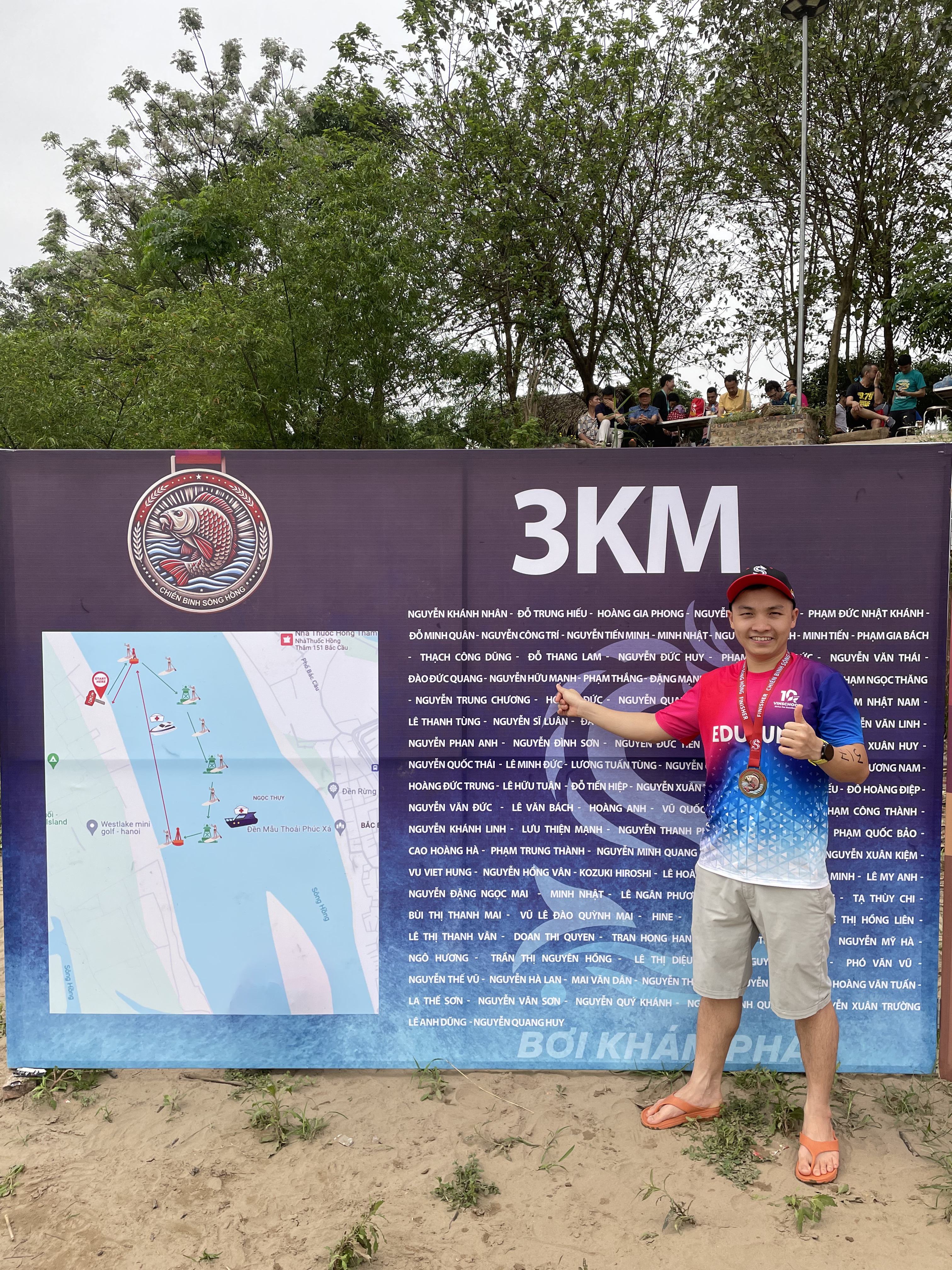
- 14-04-2024: Aqua Warriors Ha Long
This was my first time swimming in the sea and participating in a duathlon. I approached this event with the mindset of just completing it and chose a manageable distance that I could finish in about 2 hours (equivalent to the time it takes to run a half marathon), which was the Olympic distance (1.5km ![]() , 10km
, 10km ![]() ).
).
The day before the competition, seeing the calm waves at Hon Gai beach, I thought about trying the Full distance (3km ![]() , 15km
, 15km ![]() ) just to complete it. However, I believe I made the right choice in sticking to a distance that matched my training.
) just to complete it. However, I believe I made the right choice in sticking to a distance that matched my training.
Initially, I thought it would be easy to start slowly, take my time breathing, and maintain an endurance pace. However, with so many athletes, you could always be surrounded by different swimming and sighting styles. After getting kicked a few times and hit on the shoulder, I realized the harsh reality and had to continuously sight to find the best and most stable swimming path, which was much more tiring due to my limited technique.
Venturing into the duathlon was truly exciting, and it was even more thrilling to feel confident without using a float and be considered for the top 3 in my age group. Although I only finished in the top 10, it was a significant encouragement for my “first time”.
Unexpected Good Achievements:
pace 2:25
pace 5:27
-
24-04-2024: Achieved a 2:09 pace for 50m
-
02-05-2024: Started training with my second swimming coach Hoang Swim
-
15-05-2024: Achieved a 2:06 pace for 100m
-
17-06-2024: Achieved a 1:40 pace for 50m.
TIP
During this time, I realized how important my legs were in swimming. Instead of occasional kicks to save energy, I switched to continuous kicking. It was less about the kick rate and more about feeling light, even, and keeping my hips afloat by straightening my body and engaging my core. Solutions for sinking legs included: looking down, taking low breaths, and stretching out. The legs became the key to body position and stroke rhythm, rather than the arms leading the movement as I previously thought.
-
20-07-2024: Achieved a 1:51 pace for 1km, 50m x 20 (resting 1 min per length)
-
18-08-2024: Achieved a 2:05 pace for 1km, resting 1 min 30 (200m x 5)
-
21-08-2024: Achieved a 2:08 pace for 1km (35m pool)
-
29-09-2024: Aqua Warriors Van Don
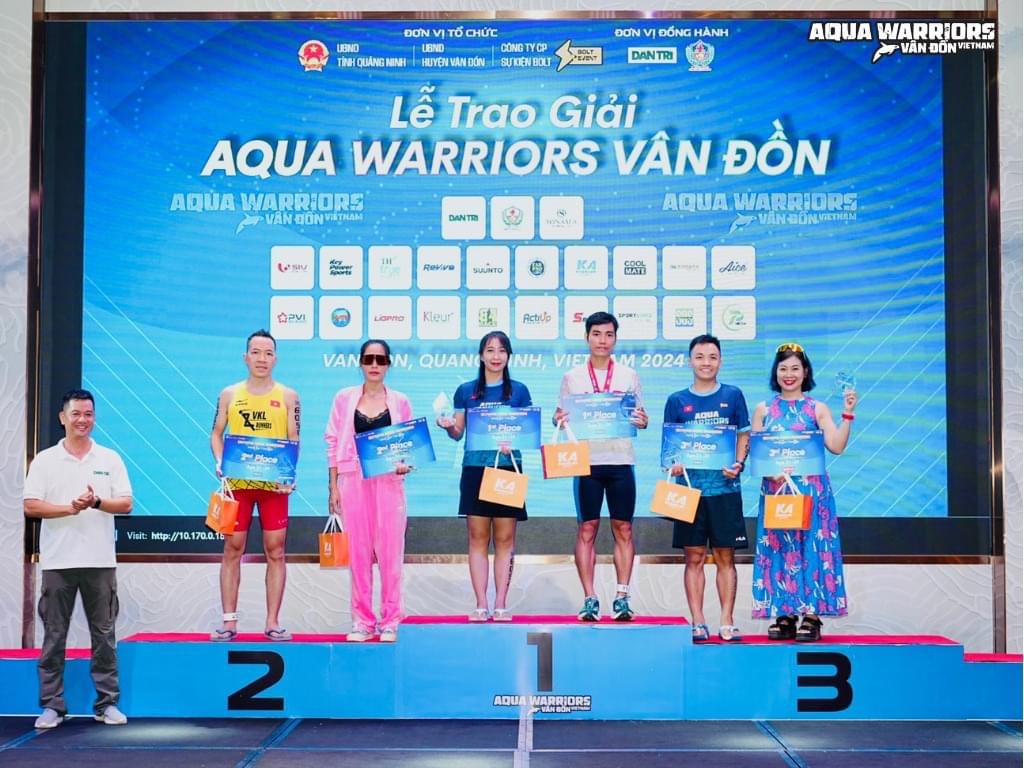
My second return to the Aquathlon with the same Olympic distance as in April, determined not to miss the top 3 age group position again. This goal was partly suggested by my second swimming coach, who believed I could swim much faster than when we first met. The timing of this event was perfect, right before my PhD studies in Australia, motivating me to participate and take my family along.
Unlike the first time, I was better prepared this time. Beyond factors like race attire (shoes or sandals, what shirt or pants to wear, whether to wear goggles or a cap), the most crucial aspect was having a clear weekly training plan. A month before the race, I dedicated time to open water swimming and weekly brick sessions (simulating race day).
I achieved my goal of finishing in the top 3 age group with the support and congratulations of my family, bringing me immense happiness.
Surprising results - Top 3 age group (30-39):
pace 2:35. Note that unlike April, this time the chip time included the swimming part and running on the sand, actual pace ~2:20.
pace 5:20
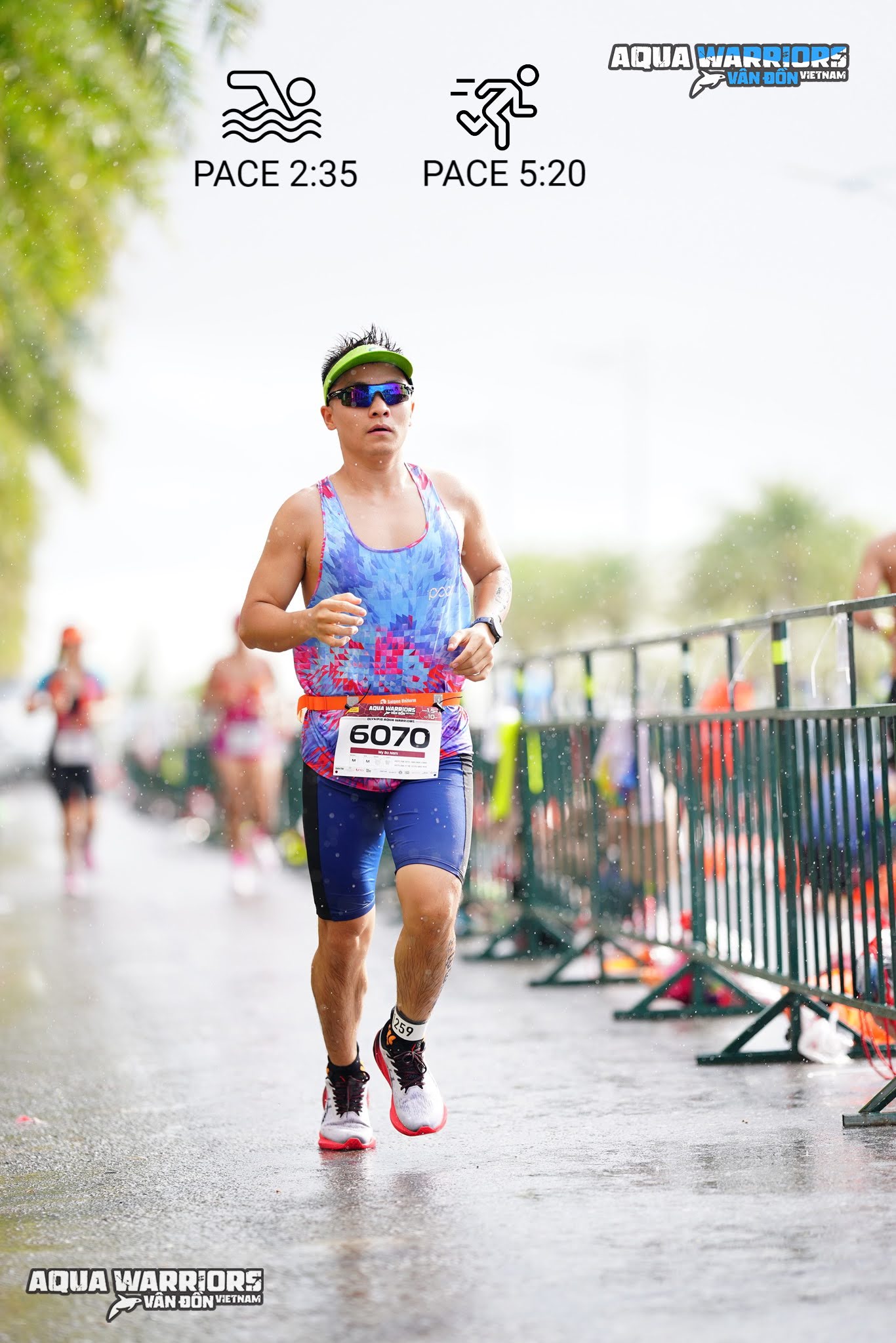
WARNING
Despite this, I felt my pre-race training intensity was insufficient and not as rigorous as the actual race, suggesting room for improvement. For instance, improving my swimming pace to 2:10 and standing up to avoid breaststroke and overtaking could enhance my performance. Additionally, independent time and less crowded lanes could help split the pack early. The running segment could also improve to a 5:00 pace.
3. My coaches
My first coach was a former competitive swimmer who taught at the pool in my neighborhood. He previously competed in the city’s team and participated in relays for Ironman events. He mentioned my technique needed to be “rebuilt from scratch” because although it looked correct, I needed to understand the principles or “feel” it. His methodical approach to teaching, from warm-ups and softening movements (legs, arms, shoulders) to flexibility exercises, significantly improved my skills. This foundation helped me complete my first two open water races. However, I felt it required a lot of time to progress and struggled with creating an effective training plan, so I sought another coach for my end-of-year event (Aqua Warriors Van Don).
My second coach graduated as an engineer but switched to teaching swimming as a hobby. He was the coach of one of my “run buddies”. While he wasn’t as fast as a competitive swimmer (likely pacing around 1:30-1:40), his passion and enthusiasm stood out. Throughout the 16 sessions, I appreciated his detailed analysis and explanations of technique principles, constantly demonstrating for the students. Each session was an hour long, focused, beneficial, and not drawn-out.

Moreover, his teaching was very up-to-date, incorporating insights from international YouTube channels (e.g. Effortless Swimming). This approach introduced me to hip rotation (instead of shoulder rotation), significantly improving my technique without dedicating excessive time to flexibility exercises. He set a sub-2 goal (1km in 20 minutes) for me, even though I never thought I could swim that fast. Despite the course being primarily freestyle, through asking questions, I also learned butterfly and backstroke. Currently, I can better feel the water, identify and correct mistakes, and set appropriate training plans.
TIP
Many Swimming Teachers
Unlike finding my first coach, I hesitated to seek a second coach, doubting the need for multiple instructors. Gradually, I observed that having multiple coaches is common for a sport requiring technical skills and training like swimming. Each coach has different methods and approaches, and being open to learning and practicing ensures progress. However, finding a dedicated coach helps you advance quicker and further.
While I didn’t start with a coach, learning proper swimming techniques from the beginning is crucial. Early mistakes can be hard to correct later and may even cause muscle pain or injuries. Additionally, watching videos or getting feedback from others can help identify and correct mistakes, allowing you to find the technique that best suits you.
4. Summary of Swimming Techniques
The more I swim, the more I realize how crucial the feel of the water is in swimming. To swim more effortlessly and glide better, paying attention to this feeling is essential. However, achieving it isn’t easy, and not every swimming session provides that “feel”. Therefore, each time I swim, I note my observations, the techniques I try, and their effectiveness. If I’m lucky to have someone record a video of me in a quiet pool, I use it as a reference for further evaluation at home. This note-taking has resulted in quite a long list, and here I’ll try to summarize some key techniques.
a. Freestyle
-
General Mindset: Relax and maintain the most streamlined position possible to reduce drag.
-
Breathing:
-
Importance: Most crucial aspect.
-
Inhale through the nose slowly underwater, exhale fully through the mouth when turning to breathe.
-
Rhythm: 2 or 3 strokes per breath. A 3-stroke rhythm is better for long-term balance, rotating the neck and shoulders evenly to avoid soreness. Being able to breathe on both sides (not necessarily in a 3-stroke rhythm) is equally important in open water swimming to reduce the need for frequent sighting.
-
Deep Breathing: For endurance swimming, exhale fully underwater and open the mouth wide or inhale deeply when turning the head to maximize oxygen intake.
-
Aim to keep the head as low as possible while breathing, ideally with one goggle in the water and one above, and just enough of the mouth above the water surface.
-
-
Arms:
-
Keep hands straight in all circumstances to maximize water contact.
-
Arms should be shoulder-width apart, avoiding inward crossing that disrupts body alignment.
-
Pull Phase: Lightly pull the hand (release it) until the elbow forms a right angle with the bottom (high elbow).
-
Catch Phase: Pushing water is the main power phase; push until fingers touch the thigh to finish.
-
Recovery Phase: Relax the hand while bringing it back to prepare for the next stroke. This phase should be slow, with a high elbow (lifted arm) if possible, then extend the arm straight forward (keeping the head low close to the arm) to pull the body forward.
-
-
Legs:
-
Avoid bending knees; generate force from the hips and thighs.
-
Quick, small leg movements.
-
Kick continuously, lightly, and steadily, gradually shifting to a 6-beat, 4-beat, or 2-beat kick rhythm based on body feedback.
-
Since swimming relies largely on the legs tilting, allocate time for appropriate training.
-
-
Body Position:
-
Generally, maintain a straight body - streamline as much as possible.
-
Keep the head low by looking down at the bottom (instead of forward) and keeping the chin close to the chest.
-
-
Hips:
-
Lightly engage hips during swimming. In speed swimming, the hips will continuously rotate to increase stroke frequency.
-
The body rotation sequence should start from the hips → shoulders → head.
-
TIP
In open water or endurance swimming, start very lightly, relax, maintain a steady kick, breathe deeply, and inhale strongly (producing a hissing sound). These keywords are important reminders for myself before and during swimming.
b. Survival Swimming
-
Treading Water: Use a combination of breaststroke/freestyle/flutter kick with hands to stay afloat in place.
-
Swimming with Head Up: You can swim breaststroke or freestyle with your head up. Freestyle with the head up is quite tiring, so for survival swimming, breaststroke with the head up is preferred. Unlike competitive breaststroke, head-up breaststroke maintains a 45-degree angle, with the head just above the water surface and hands pushing the water outwards.
-
Survival Dips/Relaxing in Place: Instead of keeping the head fully above water, allow it to sink for a few seconds of each cycle. Exhale while submerged and use hands, feet, or both to push yourself back up to breathe.
-
Sighting: Use either breaststroke sighting or a single head-up stroke during freestyle. This head-up stroke can be a low or high head lift (more tiring) to breathe. After this sighting phase, the position is often lost and becomes more tiring, so if you swim straight and well, the frequency of sighting will reduce, significantly improving speed.
c. Overcoming the Swimming Slump
Swimming training can inevitably lead to the “blue”, where regular practice doesn’t seem to improve, persistent mistakes remain, or speed training hampers endurance and vice versa. Even though once you know how to swim, you will always know how, just not maintaining practice (e.g., <1 session/week) means needing a few sessions to regain previous form. This is normal in sports training, and we should face it directly by:
-
Finding and trying different solutions and approaches.
-
Setting realistic expectations, e.g., why swim in the first place?
Deciding to swim open water taught me several lessons. Open water swimming leads to more accurate swimming technique training. We need to learn many survival skills to stay safe and enjoy great experiences. A good open water location (lake, river) is better than a swimming pool because it doesn’t use cleaning chemicals, and there’s no lane congestion as in indoor swimming. Moreover, open water swimming is also less boring due to constantly changing scenery and views you can’t see from the shore or in a pool.
5. Discovering a Passion for Swimming and Understanding Myself
a. Discovering a Passion for Swimming
-
Swimming is a sport that can be enjoyed for longer than running. While I believe I can run until I’m 60, I think I can swim until I’m 70. Once you know how to swim, you can swim for almost your entire life.
-
Swimming is an essential survival skill and a suitable sport for all ages.
-
Additionally, swimming evenly impacts the entire body, leading to a better overall physique compared to long-distance running. Given its technical nature and the involvement of various muscle groups, proper training is crucial; otherwise, mistakes become difficult to correct later on.
b. Benefits of Multi-Sport Activities
Multi-sport activities are excellent for outdoor exercises, providing a refreshing experience and preventing boredom, unlike half or full marathons. I quit running marathons after participating in duathlons compared to 2023 (every FM in each month in three last month of 2023). Engaging in an additional sport means acquiring new skills and experiences.
c. Embracing Open Water Swimming
Approaching open water swimming helped me understand myself and change my mindset about sports. I realized we can achieve amazing things by improving daily. I now prioritize improving performance over solely focusing on endurance, maintaining a much better sense of excitement, especially nearing the finish line. From my experience and observations, we shouldn’t exercise for too long, e.g., more than an hour a day. Currently, I maintain a “fun” run of 5-8 km daily, with a long run on weekends of 10-15 km, occasionally participating in events with a maximum distance of a half marathon.
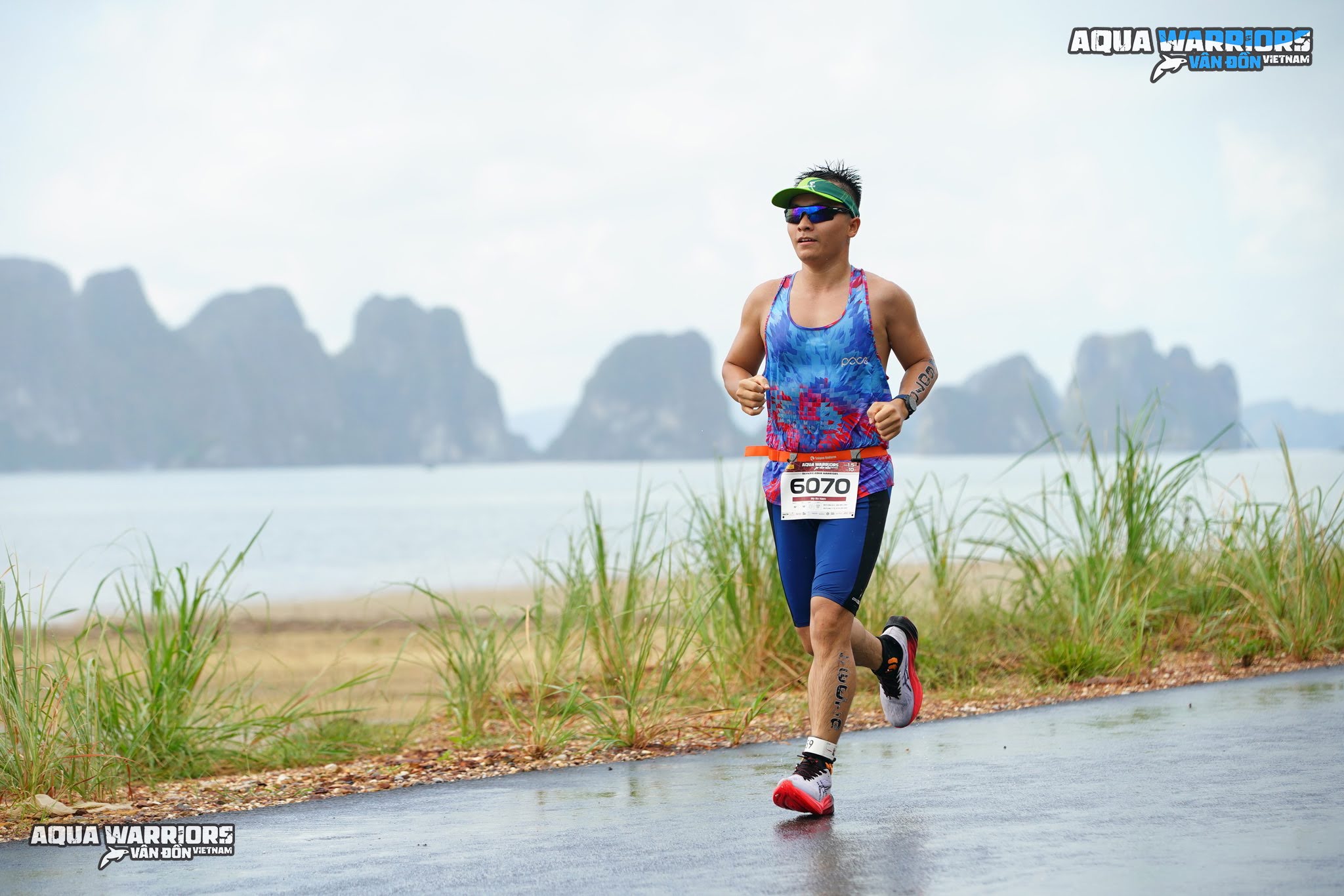
d. From Fun Runs to Warrior Mindsets
Post-Covid (2022), sports competitions in Vietnam have significantly increased in both quantity and quality across various provinces, inevitably leading to commercialization. Therefore, participating in competitions requires more selective choices and proper training plans. I believe entering a race with the mindset of fighting like warriors for a new Personal Record is essential. If previously fun runs and races aimed at finishing, now the goal is to fight hard in the race for a truly thrilling and rewarding experience. I think pursuing performance to explore personal limits is worthwhile but should be balanced with health considerations and choosing events that suit one’s physical condition and training plan. Winning a podium spot creates many opportunities and excitement, much more than participating just to finish.
TIP
As I have encouraged running, I should not neglect to encourage people to swim. Swimming is an essential survival skill and a highly effective and beneficial sport. It also serves as a great stepping stone for trying other outdoor sports like trail running.
Enjoy Reading This Article?
Here are some more articles you might like to read next: